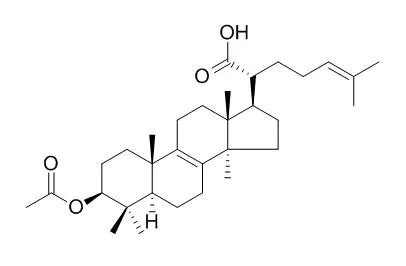The antiinflammatory properties of triterpenoids and steroids from both Ganoderma lucidum and Ganoderma tsugae were studied.
METHODS AND RESULTS:
Twelve compounds, including ergosta-7,22-dien-3beta-ol (1), ergosta-7,22-dien-3beta-yl palmitate (2), ergosta-7,22-dien-3-one (3), ergosta-7,22-dien-2beta,3alpha,9alpha-triol (4), 5alpha,8alpha-epidioxyergosta-6,22-dien-3beta-ol (5), ganoderal A (6), ganoderal B (7), ganoderic aldehyde A (8), Tsugaric acid A (9), 3-oxo-5alpha-lanosta-8,24-dien-21-oic acid (10), 3alpha-acetoxy-5alpha-lanosta-8,24-dien-21-oic acid ester beta-d-glucoside (11), and tsugaric acid B (12), were assessed in vitro by determining their inhibitory effects on the chemical mediators released from mast cells, neutrophils, and macrophages.
CONCLUSIONS:
Compound 10 showed a significant inhibitory effect on the release of beta-glucuronidase from rat neutrophils stimulated with formyl-Met-Leu-Phe (fMLP)/cytochalasin B (CB) whereas compound 9 significantly inhibited superoxide anion formation in fMLP/CB-stimulated rat neutrophils. Compound 10 also exhibited a potent inhibitory effect on NO production in lipopolysaccharide (LPS)/interferon-gamma (IFN-gamma)-stimulated N9 microglial cells. Moreover, compound 9 was also able to protect human keratinocytes against damage induced by ultraviolet B (UV B) light, which indicated 9 could protect keratinocytes from photodamage. |






 Cell. 2018 Jan 11;172(1-2):249-261.e12. doi: 10.1016/j.cell.2017.12.019.IF=36.216(2019)
Cell. 2018 Jan 11;172(1-2):249-261.e12. doi: 10.1016/j.cell.2017.12.019.IF=36.216(2019) Cell Metab. 2020 Mar 3;31(3):534-548.e5. doi: 10.1016/j.cmet.2020.01.002.IF=22.415(2019)
Cell Metab. 2020 Mar 3;31(3):534-548.e5. doi: 10.1016/j.cmet.2020.01.002.IF=22.415(2019) Mol Cell. 2017 Nov 16;68(4):673-685.e6. doi: 10.1016/j.molcel.2017.10.022.IF=14.548(2019)
Mol Cell. 2017 Nov 16;68(4):673-685.e6. doi: 10.1016/j.molcel.2017.10.022.IF=14.548(2019)